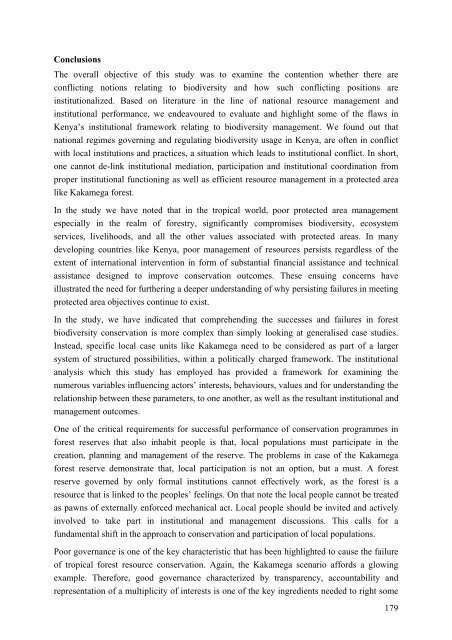THE UNIVERSITY OF LEIPZIG
THE UNIVERSITY OF LEIPZIG
THE UNIVERSITY OF LEIPZIG
You also want an ePaper? Increase the reach of your titles
YUMPU automatically turns print PDFs into web optimized ePapers that Google loves.
Conclusions<br />
The overall objective of this study was to examine the contention whether there are<br />
conflicting notions relating to biodiversity and how such conflicting positions are<br />
institutionalized. Based on literature in the line of national resource management and<br />
institutional performance, we endeavoured to evaluate and highlight some of the flaws in<br />
Kenya’s institutional framework relating to biodiversity management. We found out that<br />
national regimes governing and regulating biodiversity usage in Kenya, are often in conflict<br />
with local institutions and practices, a situation which leads to institutional conflict. In short,<br />
one cannot de-link institutional mediation, participation and institutional coordination from<br />
proper institutional functioning as well as efficient resource management in a protected area<br />
like Kakamega forest.<br />
In the study we have noted that in the tropical world, poor protected area management<br />
especially in the realm of forestry, significantly compromises biodiversity, ecosystem<br />
services, livelihoods, and all the other values associated with protected areas. In many<br />
developing countries like Kenya, poor management of resources persists regardless of the<br />
extent of international intervention in form of substantial financial assistance and technical<br />
assistance designed to improve conservation outcomes. These ensuing concerns have<br />
illustrated the need for furthering a deeper understanding of why persisting failures in meeting<br />
protected area objectives continue to exist.<br />
In the study, we have indicated that comprehending the successes and failures in forest<br />
biodiversity conservation is more complex than simply looking at generalised case studies.<br />
Instead, specific local case units like Kakamega need to be considered as part of a larger<br />
system of structured possibilities, within a politically charged framework. The institutional<br />
analysis which this study has employed has provided a framework for examining the<br />
numerous variables influencing actors’ interests, behaviours, values and for understanding the<br />
relationship between these parameters, to one another, as well as the resultant institutional and<br />
management outcomes.<br />
One of the critical requirements for successful performance of conservation programmes in<br />
forest reserves that also inhabit people is that, local populations must participate in the<br />
creation, planning and management of the reserve. The problems in case of the Kakamega<br />
forest reserve demonstrate that, local participation is not an option, but a must. A forest<br />
reserve governed by only formal institutions cannot effectively work, as the forest is a<br />
resource that is linked to the peoples’ feelings. On that note the local people cannot be treated<br />
as pawns of externally enforced mechanical act. Local people should be invited and actively<br />
involved to take part in institutional and management discussions. This calls for a<br />
fundamental shift in the approach to conservation and participation of local populations.<br />
Poor governance is one of the key characteristic that has been highlighted to cause the failure<br />
of tropical forest resource conservation. Again, the Kakamega scenario affords a glowing<br />
example. Therefore, good governance characterized by transparency, accountability and<br />
representation of a multiplicity of interests is one of the key ingredients needed to right some<br />
179






